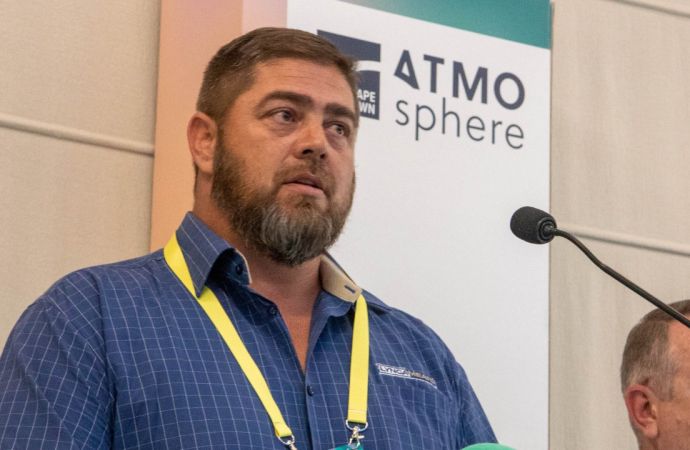During the first-ever ATMOsphere Cape Town event, two major food processors discuss their experience with ammonia systems.

Andre Snyman, Lynca Meats, at ATMOpherer Cape Town
The end user panel at the first-ever ATMOsphere Cape Town conference, held on March 10 in South Africa, featured representatives of three retailers, who installed CO2 systems, and two food processors, who installed ammonia systems. All of them had had positive experiences with natural refrigerants.
The panel was one of more than 20 presentations on local and global market trends as well as new technology and policy, with 150+ attendees from around the world on hand. (ATMOsphere conferences are organized by shecco, publisher of this website.)
Andre Snyman, General Manager Lynca Meats talked about how the food processor went from HCFC to ammonia, saving a significant amount of money.
Lynca Meats is located south of Johannesburg and slaughters, debones and processes roughly 3,000 pigs a day. Five years ago, the company decided to expand, and required a partner to assist it with utilities planning. At the time, the Lynca operation was driven by more than 80 simplex refrigeration units, charged with HCFC refrigerant, which was being phased out. It was struggling with downtime and breakages and keeping up with the maintenance of so many systems was a real problem, noted Snyman.
Luckily, Lynca met South Africa-based energy solutions provider Energy Partners (EP), which could assist with measuring and improving efficiencies. Among other things, EP helped with the upgrading of the refrigerant system.
Lynca’s first job was to install a flexible refrigeration system that could handle its primary duties (chilling and freezing of meat) reliably and efficiently. To that end, EP designed an ammonia system with a capacity of 792kW (225.2TR) capacity that allowed Lynca to almost double its production within the limitations of its electrical supply. With this system, it managed to replace some of the simplex units; the rest were later replaced with an HFC multiplex system on a cooling-as-a-service (CaaS) model.
Second, by using heat recovery for hot water production and outsourcing its steam facility to EP Steam, Lynca was able to reduce the cost of heating by 37%. Also, a 962kW solar system was added in a power purchase agreement (PPA) to reduce the effective cost of electricity. “On a like-for-like basis, these projects are saving us ZAR1.4 million [US$74,994] per year,” said Snyman.
With its CaaS and PPA contracts now in their second year, Lynca’s experience with these models has been “very positive,” said Snyman. Altogether, the outsourcing exercise has saved the food processor a significant amount in operational costs – in excess of ZAR3 million (US$160,700) per year, according to Snyman. It managed to grow its business by 70% without increasing the electricity bill.
But it’s not just about the money. Another benefit was not having to invest capital in non-core utilities, allowing for a more focused expansion of production. “Our management team can focus on the primary production needs, knowing that our utilities are being looked after by a group of specialists,” said Snyman.
Lynca Meats is once again looking to expand and Snyman confirmed that it is considering ammonia on a CaaS model.
RCL FOODS’ 45-YEAR JOURNEY WITH AMMONIA
Neshen Moodley, Group Sustainability Projects and Innovations Engineer for food manufacturer RCL Foods, spoke about using a large-scale ammonia system in its poultry business.
RCL processes 1,300 metric tons of chicken daily -- 11 chickens per second. It has been utilizing ammonia for 45 years without a single fatality. Its systems offer a refrigeration capacity of 47,900kW (13,620TR), which includes 61 compressors (59 screws) and absorbed motor power of 17,170kW. The system configuration is typically two-stage with evaporative condensers. One stage is generally -10°C (14°F) and the other -40°C (-40°F).
Heat recovery through oil cooling and de-superheating is used for the heating process and for cleaning water. Most of the engine rooms are more than 25 years old, but they have been well maintained and can still efficiently sustain the production base load, said Moodley.
He went on to speak about why RCL chose ammonia, and listed a variety of pros such as its low price, that it is a natural refrigerant and readily available, and that it has no temperature glide and can be used in flooded systems. All of RCL’s production equipment (such as spiral and carton freezers) requires a flooded design.
Ammonia is also easy to use and it’s compatible with normal mineral oils, avoiding the polyester lubricants that have to be used with fluorinated refrigerants and are very hydroscopic, he said. Ammonia is not as greatly affected by moisture in the system or by refrigerant shortages; it is also good for heat recovery.
His list of ammonia’s advantages also included:
-- It’s ideal for pumped circulation in large plants.
-- Heat-transfer coefficients are almost double those of fluorinated refrigerants, reducing the size of evaporators and condensers.
-- It has a lower gas density, leading to lower pressure drops in suction piping.
-- Flooded systems (vs. direct expansion) make better use of evaporator surface.
-- Flooded operation is easier than with synthetic refrigerants as ammonia and mineral oil are immiscible – no oil rectifier is needed.
He then spoke about RCL’s future with ammonia. “Ammonia is not going anywhere for us,” Moodley said. The plan is to maintain its systems while also looking at new technology to optimize the systems and reduce footprints.
In terms of new acquisitions of companies, Moodley said that RCL wants to look at converting them to ammonia, which enables an increased focus on heat recovery as well as water and electricity savings.
On a like-for-like basis, these projects are saving us ZAR1.4 million [US$74,994] per year.”
– Andre Snyman, Lynca Meats
Related stories



